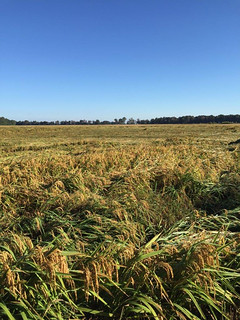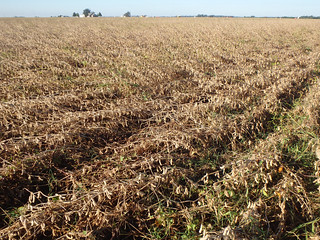Storms deliver damaging winds, soaking rains for some
October 3, 2014
Fast facts
- Extensive wind damage from Thursday night storms
- Thousands left without power
- Rain in eastern Arkansas may halt harvest for a few days
(442 words)
LAKE VILLAGE, Ark. -- A deadly line of storms that rumbled across Arkansas on Thursday night flattened some soybean and rice fields and could bring harvest to a halt for a few days, Cooperative Extension Service agents said Friday.
The storms that hit the state were part of a long line that swept from Texas to the Great Lakes. A Malvern man was killed when a tree fell on his house. The National Weather Service at Little Rock received scores of damage reports, including destruction of a farm shop in Lonoke County and a semitruck with chicken parts being blown over near Newport. More than 30,000 people were still without power Friday. Entergy said utilities in Georgia, Tennessee, Michigan and Louisiana heading to Arkansas to help restore electricity.
Jefferson County Extension Agent Anthony Whittngton said he had to step over downed powerlines to get to his truck Friday morning.
“Where I live in Sheridan, it is a mess! Trees snapped and down everywhere, power lines down all over the place,” he said.
In Nevada County, Extension Staff Chair Melissa Beck said Thursday night that there was widespread damage due to straight line winds.
“The county judge said his crews would be working through the night to remove trees from roads,” she said. Beck and her husband “Drove our fences in the rain with a spotlight to make sure our cattle couldn't get out. Now just sitting in the dark using the last of my cell phone battery.”
Mixed effects on farms
“I’m hearing reports of downed rice in the east-central and northeastern part of the state,” said Jarrod Hardke, extension rice agronomist for the University of Arkansas System Division of Agriculture. “That’s to be expected with the extremely high winds and possible tornadoes they dealt with last night.”
That flattening of crops, known as lodging, also occurred in some soybean fields in southeastern Arkansas, Hardke said.
Lodging and green snap were issues in cornfields hit by summer storms but “fortunately corn and grain sorghum harvest is nearly complete,” said Jason Kelley, extension wheat and small grains agronomist.
However, “rain we received will be helpful for wheat planting,” he said. “Soil conditions were too dry to plant wheat in most areas prior to this rain, so this rain will help add moisture and allow producers to get wheat seedbeds ready for planting.”
In Phillips County on the Mississippi River, Robert Goodson, extension agent for the University of Arkansas System Division of Agriculture said Helena-West Helena saw about .9 to an inch of rain.
“There was one report of a center pivot turned over due to wind,” he said. “Electricity was out about five hours in some places. This was the first rain in several days and farmers should be back in the field Sunday or Monday.”
In Chicot County in far southeastern Arkansas, rain gauges showed anywhere from a half-inch to 1.5 inches of rain.
“This will keep these guys out of the fields until Sunday or Monday,” said Gus Wilson, Chicot County extension staff chair for the University of Arkansas System Division of Agriculture.
He said growers in his county had finished up the corn harvest, were about three-quarters of the way through soybeans, halfway through rice, but had only started on cotton.
In northwest Arkansas, where drought persists, Washington County Extension Staff Chair Berni Kurz said he saw less than a quarter in at his house. “We could’ve used some rain. Maybe next time.”
For more information on crop production, visit your county extension office or see us online at www.uaex.uada.edu or http://arkansascrops.com.
Pursuant to 7 CFR § 15.3, the University of Arkansas System Division of Agriculture offers all its Extension and Research programs and services (including employment) without regard to race, color, sex, national origin, religion, age, disability, marital or veteran status, genetic information, sexual preference, pregnancy or any other legally protected status, and is an equal opportunity institution.
By Mary Hightower
U of Arkansas System Division of Agriculture
Media Contact: Mary Hightower
Dir. of Communication Services
U of A Division of Agriculture
Cooperative Extension Service
(501) 671-2126
mhightower@uada.edu
Related Links



